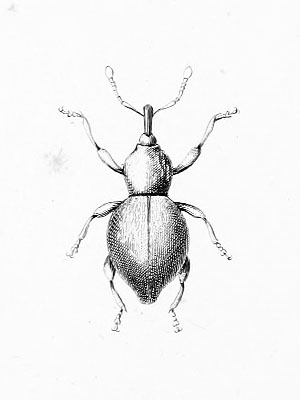Bearded Nesiobius Weevil (Nesiobius barbatus)
The Bearded Nesiobius Weevil was described in the year 1877 by T. V. Wollaston on the basis of just three specimens, that he had collected by himself at a difficult to access slope at High Peak on the island of Saint Helena.:
“The only three examples which I have yet seen of this very rare Nesiotes were taken by myself on a precipitous and barely accessible slope behind High Peak and overlooking Peak Gut; and, in conjunction with the N. fimbriatus from Thompson’s Wood, it possesses a peculiar interest through the fact of its scape being powerfully barbed towards the inner apex with a cluster of coarse, elongated, squamiform bristles. This latter character, which is only faintly traceable in some of the other members of the group (and which, indeed, in the N. squamosus and simplex appears to be altogether absent), is so conspicuous in the barbatus and fimbriatus that, when taken in connexion with heir minute but very prominent eyes, the stronger and more erect setae of their entire surface, and their anteriorly much constricted prothorax, it is sufficient to place them in a different section of the genus ….” [1]
***
The species inhabited the forests dominated by the endemic Bastard Gumwood (Commidendrum rotundifolium(Roxb.) DC.), a tree species that is now completely extinct; the beetle was not fund during the recent field searches and is very likely extinct. [2]
***
The depiction below shows the Scaled Nesiobius Weevil (Nesiobius squamosus (Wollaston)); one of the still extant species of the genus.
*********************
References:
[1] T. Vernon Wollaston: Coleoptera Sanctae-Helenae. London: John Van Voorst, Paternoster Row 1877
[2] Howard Mendel; Philip Ashmole; Myrtle Ashmole: Invertebrates of the Central Peaks and Peak Dale, St Helena. 2008
*********************

Depiction from: ‚T. Vernon Wollaston: Coleoptera Sanctae-Helenae. London: John Van Voorst, Paternoster Row 1877‘
(public domain)
*********************
edited: 29.05.2021
